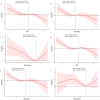Association of oxidative balance score with cardiovascular disease and all-cause and cardiovascular mortality in American adults with type 2 diabetes: data from the National Health and Nutrition examination survey 1999-2018
- PMID: 39736858
- PMCID: PMC11682987
- DOI: 10.3389/fendo.2024.1458039
Association of oxidative balance score with cardiovascular disease and all-cause and cardiovascular mortality in American adults with type 2 diabetes: data from the National Health and Nutrition examination survey 1999-2018
Abstract
Background: Oxidative stress has an important role in type 2 diabetes (T2D). Oxidative balance score (OBS) is an emerging assessment of dietary and lifestyle oxidative balance. We aimed to explore the association of OBS with cardiovascular disease (CVD) and all-cause and CVD mortality in the T2D population through NHANES 1999-2018.
Methods: OBS integrated 16 dietary components and 4 lifestyle components. T2D was diagnosed according to the American Diabetes Association criteria. Multivariate logistic regression and multivariate Cox proportional hazards regression analyses were used to explore the association of OBS with CVD and mortality in T2D, respectively.
Results: 3801 adult T2D participants were included. In fully adjusted models, OBS, dietary OBS, and lifestyle OBS were all negatively associated with the prevalence of CVD (odds ratios of 0.98, 0.98, and 0.85, respectively). Higher OBS and lifestyle OBS (p for trend 0.016 and <0.001, respectively) rather than dietary OBS (p for trend = 0.06) were associated with significantly lower odds of CVD. Higher OBS, dietary OBS, and lifestyle OBS were all negatively associated with all-cause mortality (hazard ratios [HR] of 0.98, 0.98, and 0.92, respectively; p for trend of 0.002, 0.009, and 0.035, respectively). Higher OBS and dietary OBS were negatively associated with CVD mortality (HR 0.96 and 0.95, respectively; p for trend both <0.001), whereas lifestyle OBS was not. Restricted cubic spline analysis suggested that most associations were linear. Stratified analyses showed that these associations were influenced by some demographic variables and disease status.
Conclusions: Adherence to higher OBS was associated with reduced CVD prevalence and mortality risk in T2D. Antioxidant diet and lifestyle had more significant associations with mortality and CVD prevalence, respectively. However, as these findings are merely associations and do not allow causal inferences to be drawn, future validation in high-quality randomized controlled trials is needed.
Keywords: cardiovascular disease; mortality; oxidative balance score; oxidative stress; type 2 diabetes.
Copyright © 2024 Fan, Song, Chu, Li, Yue, Li and Yang.
Conflict of interest statement
The authors affirm that this research was carried out without any influence from commercial or financial interests that might be perceived as potential conflicts of interest.
Figures






Similar articles
-
Association between oxidative balance scores and all-cause and cardiovascular disease-related mortality in patients with type 2 diabetes: data from the national health and nutrition examination survey (2007-2018).BMC Public Health. 2024 Sep 27;24(1):2642. doi: 10.1186/s12889-024-20122-7. BMC Public Health. 2024. PMID: 39334056 Free PMC article.
-
Association of oxidative balance score with incident cardiovascular disease in patients with type 2 diabetes: findings of the UK Biobank study.Eur J Nutr. 2025 Mar 6;64(3):110. doi: 10.1007/s00394-024-03552-2. Eur J Nutr. 2025. PMID: 40047957
-
Association between suicidal ideation and oxidative balance score (OBS): National Health and Nutrition Examination Survey (NHANES) 2005-2018.J Affect Disord. 2025 Feb 1;370:328-336. doi: 10.1016/j.jad.2024.11.010. Epub 2024 Nov 5. J Affect Disord. 2025. PMID: 39505022
-
Association of frailty and pre-frailty with all-cause and cardiovascular mortality in diabetes: Three prospective cohorts and a meta-analysis.Ageing Res Rev. 2025 Apr;106:102696. doi: 10.1016/j.arr.2025.102696. Epub 2025 Feb 17. Ageing Res Rev. 2025. PMID: 39971101 Review.
-
Relationship between lifestyle factors and cardiovascular disease prevalence in Somaliland: A supervised machine learning approach using data from Hargeisa Group Hospital, 2024.Curr Probl Cardiol. 2025 Mar;50(3):102994. doi: 10.1016/j.cpcardiol.2025.102994. Epub 2025 Jan 17. Curr Probl Cardiol. 2025. PMID: 39828104 Review.
Cited by
-
The role of oxidative balance score in Cardiovascular-Kidney-Metabolic syndrome progression and mortality: insights from NHANES 1999-2020.Front Nutr. 2025 Jul 1;12:1597693. doi: 10.3389/fnut.2025.1597693. eCollection 2025. Front Nutr. 2025. PMID: 40667446 Free PMC article.
References
MeSH terms
LinkOut - more resources
Full Text Sources
Medical

